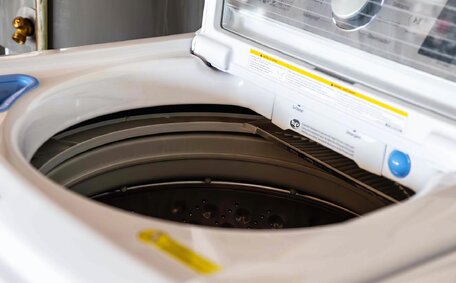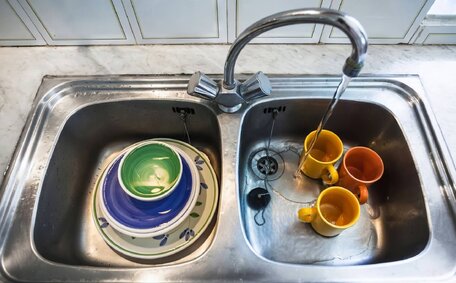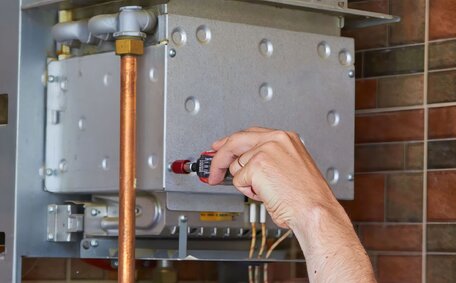Introduction to Garbage Disposal Maintenance
Keeping your disposal unit properly maintained is crucial for preventing issues like clogs, jams, and foul odours. With consistent cleaning and upkeep, you can maintain your garbage disposal unit, safeguarding your drain for the foreseeable future.
To clean your garbage disposal effectively, operate with cold water to enhance grinding efficiency, avoid hard and fibrous foods, periodically grind ice and baking soda for cleaning, and perform deep cleaning bi-weekly. Following a routine maintenance schedule will extend the lifespan of your unit and keep your system’s kitchen pipes flowing freely.
Discover essential maintenance tips for a clean and efficient garbage disposal in this guide. Ensure proper operation of your disposal to avoid costly plumbing repairs.
How a Garbage Disposal Works
A garbage disposal, nestled under your kitchen sink, is composed of several vital components that collaborate to break down food particles. At the top is a splash guard, followed by two main sections:
- The grinding chamber, which contains rotating blades attached to a turntable. Water and food waste move into unit, where the blades shred the waste into tiny fragments
- The motor, which provides the power your disposal needs to spin the turntable. This is usually an induction motor mounted underneath the disposal unit.
Direct the water flow down the drain using a utensil while the disposal is active, the blades effectively grind food waste, but be sure to switch off the garbage disposal immediately after use. As the finely ground particles journey down the drain, the garbage disposal effectively prevents clogs, aided by occasional vinegar and baking soda cleaning. Regular vinegar and baking soda cleanings prevent grease buildup, ensuring the turntable operates efficiently and remains jam-free.
By ensuring you’re cleaning your garbage with regular use and upkeep, you can keep this essential kitchen appliance running smoothly for years before needing repairs or replacement.
Common Garbage Disposal Problems to Avoid
Some of the most frequent garbage disposal issues relating to foods down the drain that require repairs include:
- Jams and clogs from putting fibrous foods like egg shells, celery, onion skins, and other difficult waste down the garbage disposal
- Foul sewer odours can be unpleasant and are often the result of food buildup and lack of regular cleaning
- Leaking water at the mounting assembly if the disposal wasn’t properly installed
- Blunt blades that produce loud noises can hinder your disposal’s ability to pulverise food
- Unit hums but doesn’t grind due to something stuck in the chamber or a jammed turntable
- Intermittent functionality from misuse leading to burned out motors
Ensure your disposal’s cleanliness by following proper cleaning and maintenance practices. Contemplate what you deposit down the disposal, prioritising suitable soft foods, and make it customary to run water. Regularly cleaning engages a kind of heating cooling process with baking soda, vinegar, and occasionally some dish soap to keep the chamber smelling fresh.
Don’t grind the wrong items down your disposal like grease, expanded food waste, or fibrous peelings; instead, use your approved items. Follow these cleaning tips, ensuring you only grind suitable waste. With consistent care as detailed in this garbage disposalhow to guide, you can turn your garbage disposal into a system offering years of reliable service.
Putting the Wrong Things Down the Disposal
Knowing what put and what not to put down your garbage disposal is crucial, as certain items can damage parts or lead to clogs. Refrain from disposing of these items in your garbage disposal:
- Egg shells - Their small fragments can build up and cause jams
- Celery stalks, corn husks, onion skins, and other stringy foods that don’t break down easily
- Expandable items like rice, pasta, or potato peels that can swell and clog pipes
- Grease or fat drippings that solidify in pipes
- Fruit pits and small bones should never be tossed into disposal
- Coffee grounds and tea bags that can collect in pipes
You also want to avoid pouring harsh chemicals like bleach or drain cleaners down clean your garbage disposal can. Such abrasive components can corrode the disposal’s inner workings.
Stick to food items your disposal is designed to handle, and review our tips maintaining a healthy appliance with materials like soft fruits and vegetables, lean meat scraps (no bones), crumbs, eggshell-less eggs, and small amounts of leftovers. Never put disposal anything down your unit that is either expansive, fibrous, or hard.
Overloading the Disposal
Excess food waste can overload the disposal, risking jams or motor burnout. As a general rule, it’s best to avoid putting more than 250g to 500g of soft food waste down the disposal and remember to turn garbage disposal only when necessary.
Use lukewarm water during operation to prevent overloading, instead of very hot water.
The flow of water can help move particles through while keeping the grinding chamber cool. Feed food scraps gradually down the drain while you let water keep running to ensure smooth operation. Use a spatula to put your remnants down.
If the disposal stops during operation, this signals an overload. Switch off the disposal and allow it to reset before resuming. Smaller batches of food waste are easier on garbage disposals and less likely to cause issues.
Failing to Properly Maintain
Proper maintenance is crucial for keeping your garbage disposal running efficiently and preventing problems. Neglecting regular cleaning and care can lead to foul odours, corrosion, jams, clogs, and even early unit failure.
To keep your disposal in good working order, turn off your appliance before maintaining and clean your garbage disposal once with a routine schedule:
- To deep clean, pour a mix of vinegar and baking soda down the drain bi-weekly, followed by flushing with water. A scrub brush can be employed to dislodge debris when you activate your disposal.
- Avoid jams by not disposing of stringy items and periodically clean with a baking soda and vinegar mix.
- Always use cold water on your disposal before, during, and seconds after use to keep food waste flowing.
- Grind ice occasionally to scour the grinding chamber interior.
- Annually, lubricate the disposal by grinding a cup of salt followed by ice cubes.
By cleaning and maintaining your disposal monthly as described, your unit will reliably serve you for many years. Prevent more costly repairs down the road by taking a few minutes for routine maintenance.
Tips for Cleaning and Maintaining Your Disposal
Follow these steps to ensure your garbage disposal is clean and well-maintained for optimal performance. Follow these tips from our expert plumbers for cleaning and care:
- Every two weeks, pour approximately a cup of baking soda followed by vinegar into the drain, then run cold water. Allow the mixture to sit for 5-10 minutes before running the disposal to wash away debris.
- Occasionally disinfect your unit by grinding up citrus peels. The citric acid helps get rid of odours.
- Prevent jams by avoiding hard foods like egg shells. Only put into your unit appropriate soft, small food particles.
- Always remember to run cold water before, during, and after using the disposal to keep waste flowing.
- Grind small ice cubes to clean the inner grinding chamber.
- Each year, lubricate with one cup of rock salt followed by ice cubes.
Taking a few minutes for regular cleaning and care will keep your garbage disposal working properly for years to come.
Dealing with Jams and Clogs
If your garbage disposal becomes jammed or clogged, follow these safe steps to clear the blockage:
- Before clearing jams, Cut the power at your home’s breaker box. Never risk your hands in a disposal with the unit off.
- Use a hex wrench or Allen key in the bottom shaft, turning it to dislodge debris.
- Try using tongs to remove visible obstructions, being careful not to damage the blades. You can also use a rubber splash guard for protection.
- If the jam doesn’t clear, you may need to press the reset button on the bottom of the unit after ensuring power is off.
Using ice cubes and vinegar can disintegrate grease buildup that often causes jams. Cleaning regularly is the best prevention against clogged units requiring repairs.
When to Call a Professional Plumber
There are a few instances when it’s best to enlist a professional plumber for optimizing your disposal’s performance rather than attempting to fix potential issues yourself:
- You’ve turned off the power but can’t manually clear a jam with tools - The unit may need to be taken apart to remove debris that get stuck.
- The reset button doesn’t restart the unit - There may be an issue with the motor or wiring.
- There are leaks coming from the mounting assembly - This indicates a failed seal that needs replacement.
- The disposal grinds very loudly or makes clunking noises - The blades or turntable are likely worn out.
- You keep getting a burning smell - There may be an electrical short or motor issue.
DIY attempts can be hazardous given the disposal’s electric components and sharp blades. Our licenced plumbers have the expertise to diagnose issues and ensure you can get your unit working safely again with proper repair or replacement procedures.
For reliable garbage disposal repairs, installations, and replacements, contact the experts at Parramatta Plumbing on 1300 349 338 or jobs@parramattaplumbingservices.com.au.
Replacing an Old or Faulty Disposal
There are a few signs indicating your garbage disposal needs replacing:
- The unit is over 10 years old
- You frequently deal with jams, clogs or foul odours even after cleaning
- The disposal is very loud or makes irregular grinding noises
- You notice leaks, cracks, corrosion or other damage
- The reset button or turning the power off/on doesn’t resolve issues
An old or faulty disposal can excessively consume energy and water, and strain your plumbing. Replacement units are more energy efficient and better equipped to handle modern kitchen usage.
When selecting a new garbage disposal, look for a unit with at least 1 HP of power, stainless steel grinding components, sound insulation, and an anti-jam swivel impeller. Choose a disposal with the right capacity for your household’s size and waste production.
Our experienced plumbers are on hand to recommend the best disposal replacement for your needs. We handle the entire installation process including removal of your old unit. Contact Parramatta Plumbing to schedule an appointment for garbage disposal replacement.






